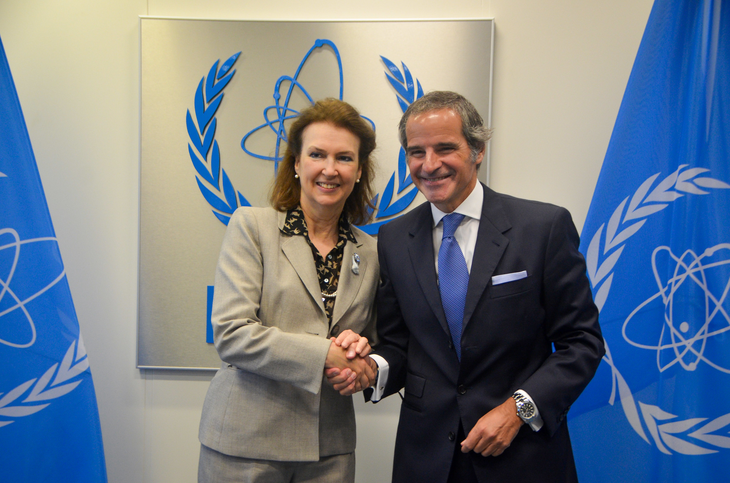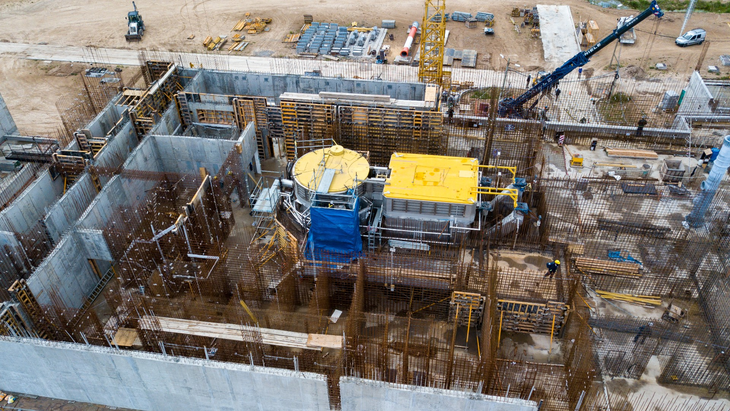Within the framework of the 68th General Conference of the International Atomic Energy Agency (IAEA) which takes place in Austria, the chancellor Diana Mondino accompanied the presentation of the RA-10 Multipurpose Research Reactor of the National Atomic Energy Commission (CNEA), which is under construction in Argentina.
Speaking at the plenary session of the Vienna Conference, Mondino ratified “the strategic character” that Argentina grants to nuclear technology and its peaceful applications, and considered our country “as a responsible and reliable producer and exporter of nuclear technology and related components to various countries around the world on all continents.”
“In a global scenario of instability and geopolitical tensions, Argentina calls for an end to nuclear rhetoric and the threat of using nuclear weapons, the use of which is unacceptable.. Argentina also echoes the Director General’s call to avoid actions that may endanger or damage nuclear facilities or facilities containing radioactive material in the context of armed conflicts. Nuclear technological security and nuclear physical security must prevail,” he stressed.
image.png
The official also reiterated that “our concern about the situation in terms of nuclear physical and technological security and the application of safeguards, resulting from the Russian-Ukrainian military conflict. We acknowledge the importance of the five missions conducted by the IAEA and its permanent presence in Ukrainian territory in order to monitor this urgent situation, as well as its recent visit to the Kursk Nuclear Power Plant. Argentina supports the extensive work and efforts of this Organization and its Director General”
The chancellor recalled the visit she made this year to Argentine Antarctica, accompanied by the president Javier Mileiand on the occasion of the presence of the Director General of the IAEA, the Argentine Rafael Grossi: “The visit to Antarctica and the signing of agreements demonstrate the capabilities that Argentina has and can offer our region and the world in terms of nuclear science and technology and its applications.”
image.png

The head of the San Martín Palace highlighted two large-scale projects that Argentina has made great progress on: the RA-10 multipurpose research reactor, which is in the final stage of construction, located in the Ezeiza Atomic Center, and the proton accelerator for use in highly advanced radiotherapy, which will be the first facility of its kind in Latin America.
In this regard, Mondino highlighted that “this is based on the “defending the principles of technological sovereignty and the inalienable right to the peaceful uses of nuclear energy” and stressed that “a fundamental pillar of this responsible and reliable approach as a producer of nuclear energy is the Brazilian-Argentine Agency for Accounting and Control of Nuclear Materials (ABACC), which has established itself as a global example of cooperation and trust between countries, in an area of extreme sensitivity.”
The Chancellor added that “we are facing a future in which nuclear energy is called upon to play a greater role based on the potential it offers as a source of clean energy. That is why Argentina promotes cooperation for secure access to these technologies.”
It should be noted that, within the framework of the Conference, lThis year, Argentina has a stand where the developments of the Argentine nuclear program will be exhibited through the National Atomic Energy Commission (CNEA) and INVAP.
The IAEA is the world’s main forum for promoting peaceful applications of nuclear technology, including the production of electric energy, within the framework of the United Nations System. Argentina has been a member of the Agency since its creation in 1957 and, since then, has continuously served on the Board of Governors (main decision-making body, which is made up of 35 members according to the level of nuclear development and geographical representation). The IAEA is an important source of technical and scientific cooperation for the Argentine nuclear sector, and also for other national entities and/or public institutions.
What is the Argentine RA-10 reactor and what is it used for?
The Chancellor Diana Mondino participated alongside the president of the CNEA, German Guido Lavalle, from a presentation event of the RA-10 Multipurpose Research Reactorwhich provided a broad overview – with details – of the reactor’s technical capabilities, as well as the status of the project and its applications for medicine and industry.
This multipurpose reactor has been designed based on the OPAL reactor sold by INVAP to Australiawill have 30 MW of power and is under construction in the Ezeiza Atomic Center (CAE), with a progress of 80%. The civil work is completely finished.
RA-10 Multipurpose Research Reactor

The project will consolidate the supply of radioisotopes for medical, industrial and agricultural use for the local and international markets, in the context of growing demand. It is planned to have various associated facilities, including a neutron beam laboratory, a fission plant for the production of different radioisotopes and a laboratory for the study of irradiated materials.
In this regard, Mondino explained that “The RA-10 will be Argentina’s contribution to solving some of our challenges in terms of health, economic development, science and energy transition. I invite you all to come to Argentina and I invite you to learn about our nuclear sector, including the RA-10 reactor. Our country has a long tradition of cooperation, capacity building and technology transfer. We are open to exploring opportunities for collaboration, which will allow us to take full advantage of the RA-10’s potential. It is, in a way, the jewel in the crown of Argentine nuclear science.”
RA-10 Multipurpose Research Reactor

Finally, the chancellor indicated that “Argentina has a long-standing commitment to the peaceful use of nuclear energy: 74 years to be more precise, with the CNEA as a cornerstone. This has allowed us to be a responsible nuclear player and export nuclear technology to all continents, through companies such as INVAP and CONUAR.”
Source: Ambito




